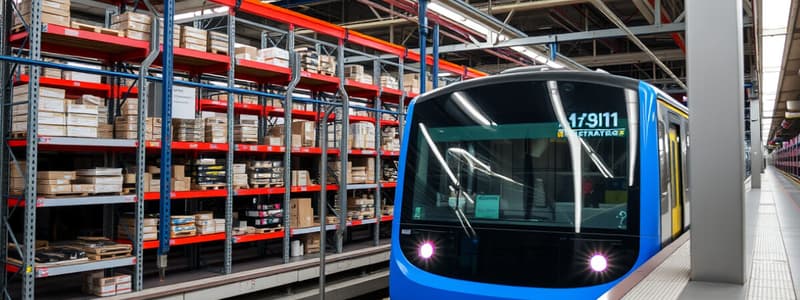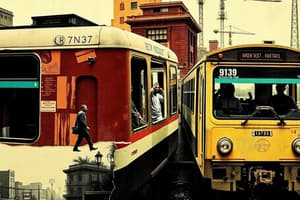Podcast
Questions and Answers
Which station is located at the I-605/I-105 junction?
Which station is located at the I-605/I-105 junction?
- Vermont Station
- Harbor Fwy Station
- Long Beach Station
- Norwalk Station (correct)
What type of information is included in the General Information section of the manual?
What type of information is included in the General Information section of the manual?
- Vehicle specifications and maintenance
- Basic details about the Metro Green Line (correct)
- Detailed station schedules
- Operational budgets and funding
Which station is associated with a mezzanine level in its structure?
Which station is associated with a mezzanine level in its structure?
- Avalon Station
- Marine/Redondo Station
- Imperial/Wilmington/Rosa Parks Station (correct)
- El Segundo/Nash Station
What does the key for symbols and abbreviations section mainly serve to clarify?
What does the key for symbols and abbreviations section mainly serve to clarify?
Which of these stations does NOT have a street-level layout provided in the manual?
Which of these stations does NOT have a street-level layout provided in the manual?
What information might you NOT find in the METRO RAIL INVENTORY SYSTEM MANUAL?
What information might you NOT find in the METRO RAIL INVENTORY SYSTEM MANUAL?
Which of the following locations includes a platform level in its layout?
Which of the following locations includes a platform level in its layout?
What is a common feature you would find across all listed stations in the manual?
What is a common feature you would find across all listed stations in the manual?
How often are the stations operational according to standard configurations in transit systems?
How often are the stations operational according to standard configurations in transit systems?
Which station is NOT mentioned directly in the manual's table of contents?
Which station is NOT mentioned directly in the manual's table of contents?
Which Metro Green Line stations do not have escalators?
Which Metro Green Line stations do not have escalators?
What is the main purpose of the Emergency Trip Stations located in BLSs?
What is the main purpose of the Emergency Trip Stations located in BLSs?
How many Metro Green Line stations have elevators?
How many Metro Green Line stations have elevators?
What does the acronym 'TPSS' stand for?
What does the acronym 'TPSS' stand for?
Which maintenance facility is mentioned for the MGL Division?
Which maintenance facility is mentioned for the MGL Division?
Which of the following stations is not equipped with an escalator?
Which of the following stations is not equipped with an escalator?
What is one of the controls for the escalators located?
What is one of the controls for the escalators located?
Which type of emergency equipment is not mentioned as being available at Metro Green Line stations?
Which type of emergency equipment is not mentioned as being available at Metro Green Line stations?
What does 'STR' represent in the operational symbols?
What does 'STR' represent in the operational symbols?
Which device would trip the automatic in-line circuit protection devices?
Which device would trip the automatic in-line circuit protection devices?
Which feature is included to comply with ADA requirements?
Which feature is included to comply with ADA requirements?
During which operational hours are Park & Ride facilities available?
During which operational hours are Park & Ride facilities available?
Which acronym represents the communications and signaling system?
Which acronym represents the communications and signaling system?
How many of the Metro Green Line stations are equipped with both escalators and elevators?
How many of the Metro Green Line stations are equipped with both escalators and elevators?
Which statement accurately describes the parking facilities available at the stations?
Which statement accurately describes the parking facilities available at the stations?
What are the characteristics of the travel elevators at the stations?
What are the characteristics of the travel elevators at the stations?
Which track is designated for westbound trains?
Which track is designated for westbound trains?
How many stops are there for the West Elevator in the MGL area?
How many stops are there for the West Elevator in the MGL area?
What role do TVMs (Ticket Vending Machines) play at the stations?
What role do TVMs (Ticket Vending Machines) play at the stations?
Which locations have communications rooms as indicated in the plans?
Which locations have communications rooms as indicated in the plans?
What can be stated about the operational hours of the stations?
What can be stated about the operational hours of the stations?
What does the term 'Park & Ride' specifically refer to in the context of the stations?
What does the term 'Park & Ride' specifically refer to in the context of the stations?
Which aspect of ridership information is pivotal for planning train schedules?
Which aspect of ridership information is pivotal for planning train schedules?
What is the primary purpose of the escalators present in the station plans?
What is the primary purpose of the escalators present in the station plans?
What type of ticketing services are provided at the terminal locations?
What type of ticketing services are provided at the terminal locations?
What is indicated by the presence of emergency stairs in the station design?
What is indicated by the presence of emergency stairs in the station design?
Which of the following locations includes an ancillary electrical room according to the plans?
Which of the following locations includes an ancillary electrical room according to the plans?
Which connecting features improve accessibility at the stations?
Which connecting features improve accessibility at the stations?
What is signified by the term 'Ancillary' in station planning?
What is signified by the term 'Ancillary' in station planning?
Flashcards are hidden until you start studying
Study Notes
METRO Green Line Overview
- The METRO Green Line is part of the METRO rail system designed for the Los Angeles Fire Department and the Los Angeles County Metropolitan Transportation Authority.
- The final version of the inventory system manual was prepared by Booz Allen Hamilton in May 2004.
Stations Included in the System
- I-605/I-105 (Norwalk) Station: Features surface map, site plan, street level, and platform level layouts.
- Lakewood Station: Similar mapping and layout details as above, ensuring clarity in station design.
- Long Beach Station: Includes detailed mapping for operational and safety purposes.
- Imperial/Wilmington/Rosa Parks Station: Features additional mezzanine level in mapping.
- Avalon Station: Provides comprehensive surface and platform layout.
- Harbor Freeway Station: Ensures access through thorough level mapping details.
- Vermont Station: Comprehensive layout information for operational protocol.
Additional Stations
- Crenshaw Station: Mapping includes multiple levels for operational efficiency.
- Hawthorne Station: Surface level and platform details emphasized.
- Aviation Station: Carefully mapped for safety and operational success.
- Mariposa/Nash Station: Includes all essential mapping plans.
- El Segundo/Nash Station: Layout details support effective station management.
- Douglas/Rosecrans Station: Well-documented for operational guidelines.
- Marine/Redondo Station: Mapping ensures compatibility with fire safety regulations.
Maintenance Facilities and Equipment
- Division 22 Maintenance Facility: Critical for ongoing vehicle maintenance and operational integrity.
- Automatic circuit protection devices are in place to manage electrical issues effectively.
- Emergency Trip Stations are available for immediate power removal in critical situations.
Accessibility Features
- All fourteen METRO Green Line stations are equipped with elevators, complying with the Americans with Disabilities Act (ADA).
- Controls for elevators located in the station EMP (Emergency Management Panel).
- Nine METRO stations feature escalators, excluding Lakewood, Avalon, Vermont, Crenshaw, and Hawthorne stations.
Symbols and Acronyms
- Blue Light Station (BLS): A key safety feature for emergency communication.
- Fire Management Panel (FMP): Centralizes fire safety management for each station.
- Smoke Detection Alarm (S): Critical for immediate fire detection and response.
- Traction Power Substation (TPSS): Provides necessary electric power for trains.
Emergency and Safety Protocols
- The inventory includes fire control panels (FCP) and hydrants (FCP) throughout the stations.
- Smoke and natural gas shutoff systems are included for safety in emergencies.
- Detailed stair (STR) and elevator (E) placements ensure safe egress for passengers.
Overall Significance
- The METRO Green Line contributes significantly to urban public transportation infrastructure, facilitating comprehensive urban mobility and safety measures across Los Angeles.
- The systematic documentation and mapping of stations ensure operational efficiency and compliance with safety regulations.### Site Plans Overview
- Various site plans include detailed layouts for locations such as Branscomb, Norwalk, Lakewood, Long Beach, Imperial/Wilmington, and Avalon.
- Each site plan features pedestrian access routes, track layouts, and key structures.
Key Components of Each Site
- Parking Areas: Each location has designated park and ride areas for convenient commuter access.
- Elevators: Multiple elevator machine rooms facilitate movement between different platform levels and public areas.
- Communications Rooms: TCCR (Train Control Communications Room) is present at several stations ensuring efficient communication systems.
Station Features
- Train Platforms: Platforms are strategically designed for both westbound and eastbound tracks, enhancing passenger convenience.
- Ticket Vending Machines (TVM): Placed in easily accessible locations to facilitate ticket purchases for riders.
Ancillary Facilities
- Electrical and Mechanical Rooms: These support station operations, with dedicated spaces for transformers and control systems.
- Emergency Stair Access: Safety features include emergency stairs for quick evacuations.
Track Access Layout
- Tracks are systematically separated into designated westbound and eastbound, allowing for smooth transit operations and preventing congestion.
- Accessibility features offer important links between platforms, enhancing commuter flow.
Plaza Areas
- Each site has distinct plaza levels (West and East Plaza) providing public gathering spots and additional services.
- Stations are connected to surrounding areas through planned roads and pathways.
Infrastructure
- FDC (Fire Department Connection) and STG (Staging Areas): Essential for safety and operational readiness during emergencies.
- TPSS (Traction Power Substation): Critical for powering electric trains, strategically located across site plans.
Site Connectivity
- All locations are designed with community connectivity in mind, integrating nearby roads, bus stations, and pedestrian pathways.
- Facilitates interchangeability between train, bus, and personal vehicle commuting options.
Key Dual-Level Dimensions
- The layouts include comprehensive levels such as street level, platform level, and mezzanine level to manage passenger flow effectively.
- Well-distributed stair and elevator access promotes efficient transitions between levels.
Additional Site-specific Notes
- Long Beach and Avalon stations feature unique designs catering to heavy commuter use due to their strategic locations.
- The overarching design of each site emphasizes safety, accessibility, and efficient transit operations across urban landscapes.
Studying That Suits You
Use AI to generate personalized quizzes and flashcards to suit your learning preferences.




